
The joy of gardening is a feeling that cannot be described in words. It is the satisfaction of seeing something you planted grow and bloom and the pleasure of being surrounded by beautiful flowers. Gardening is a way to connect with nature and appreciate the simple things in life.
If you’re looking to start a garden this summer, this article’s for you. Our guide will explain the most popular blooms and a few gardening tips to help your plants thrive.
Here are the top 5 perennial flowers that bloom all summer.
1. Geraniums- The Shade Loving Perennial
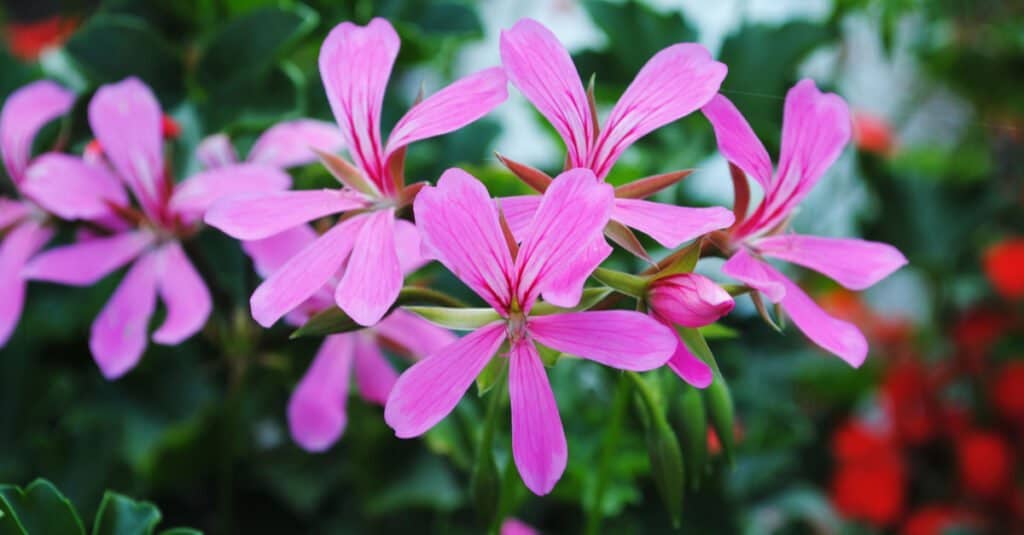
Geraniums thrive in the sun and shade.
©Peeraphat/Shutterstock.com
When it comes to perennial flowers that bloom all summer, look no further than geraniums. They grow throughout the summer with very little maintenance. Geraniums are easy to grow and thrive in both sunny and shady locations. They are one of the most popular perennials for a few reasons. For starters, they are very low maintenance. They have low water and nutrient needs and can tolerate a wide range of soil conditions. Additionally, they are resistant to most pests and diseases.
There are many different varieties of geraniums available, so you can choose the one that best suits your needs. Here are some of the different types of geraniums:
Ivy geraniums have trailing stems that make them perfect for hanging baskets or as a ground cover.
Scented-leaved geraniums are grown for their fragrant leaves. The most common variety is the lemon-scented geranium.
Zonal geraniums are the most popular type of geranium. Their large, showy flowers come in a wide range of colors. Imagine watching the butterflies hang out around these color bombs! It’ll be garden heaven.
Mosaic geraniums have variegated leaves and are often used as ornamental plants. Certain varieties are prone to bacterial wilt on the leaves, so be careful. Inspect the leaves on a regular basis, and treat them as needed.
Whether you are looking for a plant to add color to your garden or one that is easy to care for, geraniums can fit the bill.
2. Heucherella -The Colorful Perennial
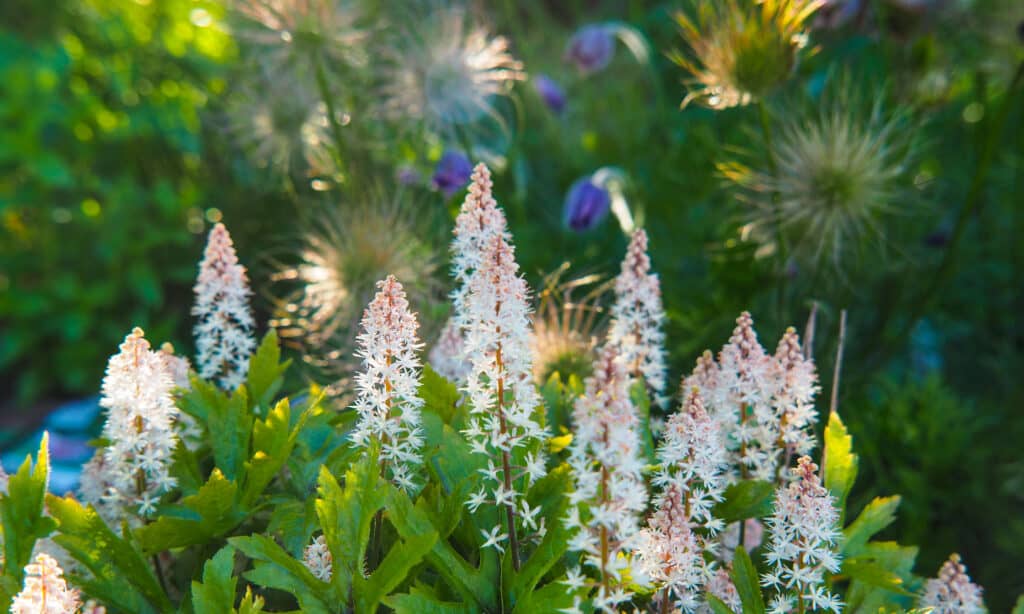
The Heucherella are low-maintenance perennial flowers.
©Anna Gratys/Shutterstock.com
Heucherella, also commonly known as Foamy Bells, is a hybrid plant that is a cross between Heuchera and Tiarella. This perennial, unlike invasive species, is native to North America. You’ll find these flowers sprouting up in woodlands, shady areas, and along streams. They’re one of the most colorful perennial flowers that bloom all summer.
The base has a mounded shape and colorful leaves. The leaves are usually heart-shaped or triangular, and they’re ruffled or wavy. They come in various colors, including green, purple, bronze, and red. Heucherella also produces small, white flowers in the spring with tall spikes. If you like spiky plants, check out the birds of paradise.
One of the benefits of growing Heucherella is that they are low maintenance. They are a relative of coral bells, which means they are drought tolerant and can tolerate a wide range of soil conditions.
Provide plenty of water in the summer months. They are drought-tolerant plants but will appreciate regular watering in hot weather. You can also fertilize them lightly once a month with a balanced fertilizer. If you want an explosion of color, think heucherellas!
3. Spiderwort- The Versatile Perennial
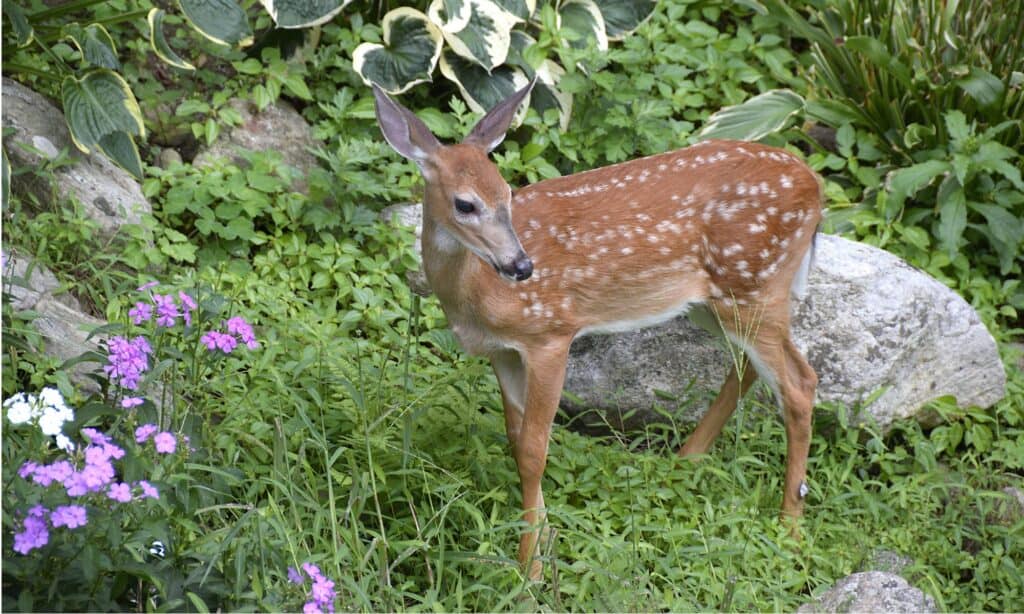
Deer enjoy eating spiderwort leaves.
©iStock.com/tmphoto98
If you want a plant that will bring color and works great for beginners, then take a look at the spiderwort plant. It is a versatile perennial for shade or sun. It’s easy to grow from purchased plants, and you can propagate them through division, cuttings, or seed.
In the spring, plant spiderworts are about 4 to 6 inches (10-15 cm.) deep and 8 to 12 inches (20.5-30.5 cm.) apart. They’ll quickly fill in any gaps and create a lush, green backdrop for your garden. The thick clumps of slender, blue blooms cover the sturdy branch stalks. The flowers have three petals and can grow up to 2 inches (5 cm.) across.
Spiderworts are large but delicate perennials that can reach up to 3 feet (1 m.) in height. They’re perfect for adding a touch of elegance to any garden. So if you’re looking for a plant that has long blooms, be sure to add spiderworts to your list!
Just make sure you keep your lovely flowers safe from common pests like aphids, mites, and thrips. You also have to keep an eye out for hungry deer or curious rabbits who will munch on your spiderwort. Thankfully, there are a lot of humane solutions you can try.
4. Stella de Oro Daylily – The Golden Perennial
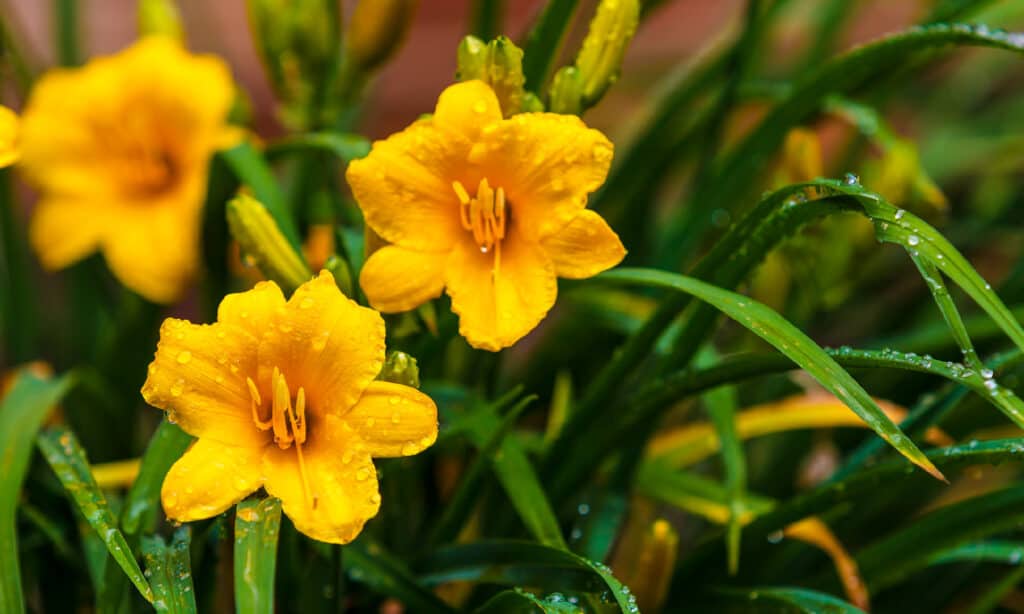
The Stella de Oro day lily blooms all summer.
©Anna Gratys/Shutterstock.com
The Stella de Oro day lily is one of the golden perennial flowers that bloom all summer. It’s easy to care for, and its bright yellow flowers are sure to add a touch of color to any garden.
Daylilies are one of the most versatile perennials available, and the Stella de Oro is no exception. This hardy plant can thrive in both sun and shade, making it perfect for any garden. It’s also drought-resistant, so you won’t have to worry about watering it often.
The Stella de Oro day lily will bloom from May until the end of summer, providing months of color and beauty. Its arching leaves make it an attractive addition to any garden, and its fragrant flowers will fill the air with a sweet aroma. When you’re looking for stunning perennials, be sure to try the Stella de Oro!
Pro-tip; When you’re planting Stella de Oro daylilies, be sure to plant them in groups of 3 or 5. This will give them the best chance to thrive and bloom. You’ll also want to make sure they’re in an area that gets at least 6 hours of sunlight per day.
5. Black-eyed Susan – The Summertime Perennial
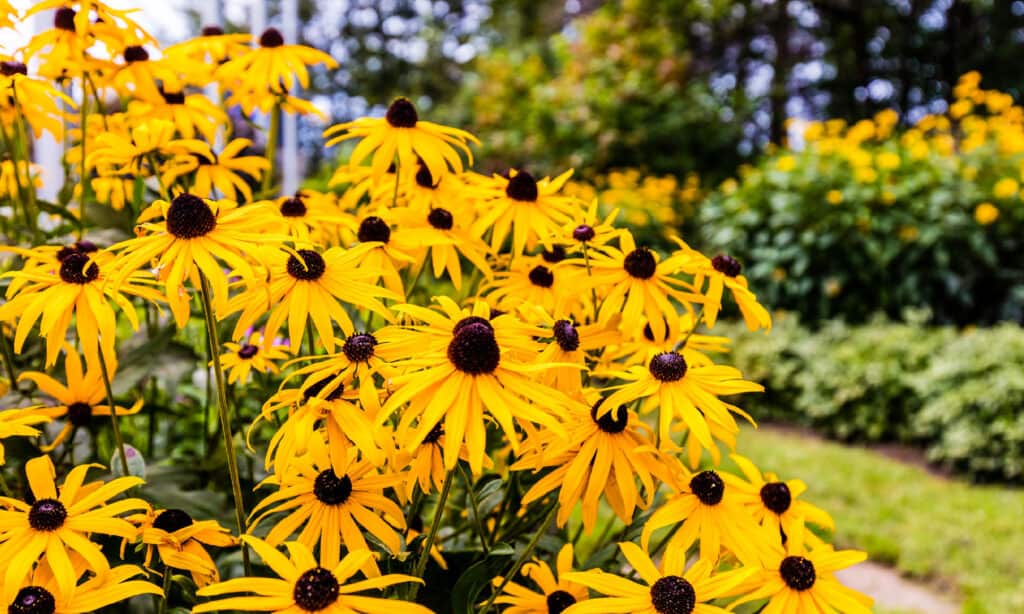
Black-eyed Susans are perfect cut flowers.
©iStock.com/Dopeyden
Last on our list of perennial flowers that bloom all summer we have the black-eyed Susan. It blooms from June to August. It’s easy to grow and care for, and its cheerful yellow flowers will brighten any garden.
Black-eyed Susans are one of the most popular perennials, and it’s easy to see why. They’re drought-resistant and are happy in shady areas or full sun. They’re also relatively low-maintenance, so you won’t have to spend a lot of time on them.
The black-eyed Susans are elegant and gorgeous. Its daisy-like flowers are a welcome addition to any garden, and its long stems make it perfect for cutting and adding to bouquets. You won’t regret planting these summer perennials.
When gardening, it helps to know what invasive plant species to look out for. Take a peek at our article’s below to be in the know.
What Animals Eat Flowers?
Flowers play a crucial role in the food chain, providing sustenance for a variety of animals. While many people think of flowers as purely ornamental, they are in fact a vital source of nutrition for many species.
Birds are one of the most well-known flower-eating animals. From hummingbirds to parrots, birds feed on the nectar from flowers, which is high in sugar and provides them with the energy they need to fly and forage for other food. In addition to nectar, some species of birds also feed on flower petals, seeds, and even flower stems.
Bees are another important flower-eating animal, as they are critical to the pollination process. Bees feed on the nectar and pollen of flowers, which they use to make honey and feed their young. In turn, their pollen-collecting activities help to fertilize flowers and promote the growth of new plants.
Insects such as butterflies and moths are also known to feed on flowers. They feed on nectar and flower petals, which provide them with the energy they need to fly and mate. Some species of insects, such as bees and wasps, also use flower nectar to make their young.
Mammals such as deer and rabbits also feed on flowers, particularly in the spring and summer when other food sources are scarce. In addition to eating the petals, they may also consume the leaves and stems of flowering plants.
Types Of Perennials Best With Pets
It is always a delight to step outside into your garden and see an abundance of beautiful flowers but not all of these are safe for everyone. Before you decide which perennial would look best in your yard, consider those that are best for dogs and cats and remember those that are not:
Best For Dogs And Cats
- Hollyhocks
- Bee Balm
- Tickseed
- Columbine
- Coral Bells
- Hens and Hicks
Worst For Dogs And Cats
- Hydrangeas
- Primroses
- Sweet Pea
- Azaleas
Bonus: Three More Pretty Perennials That Bloom All Summer
Our list of summer-blooming flowers needed a few extras to round out your gardening possibilities. These three delicate beauties are all beloved by pollinators and provide dependable, colorful blossoms all summer long. One of them even prefers shade!
Purple Coneflower
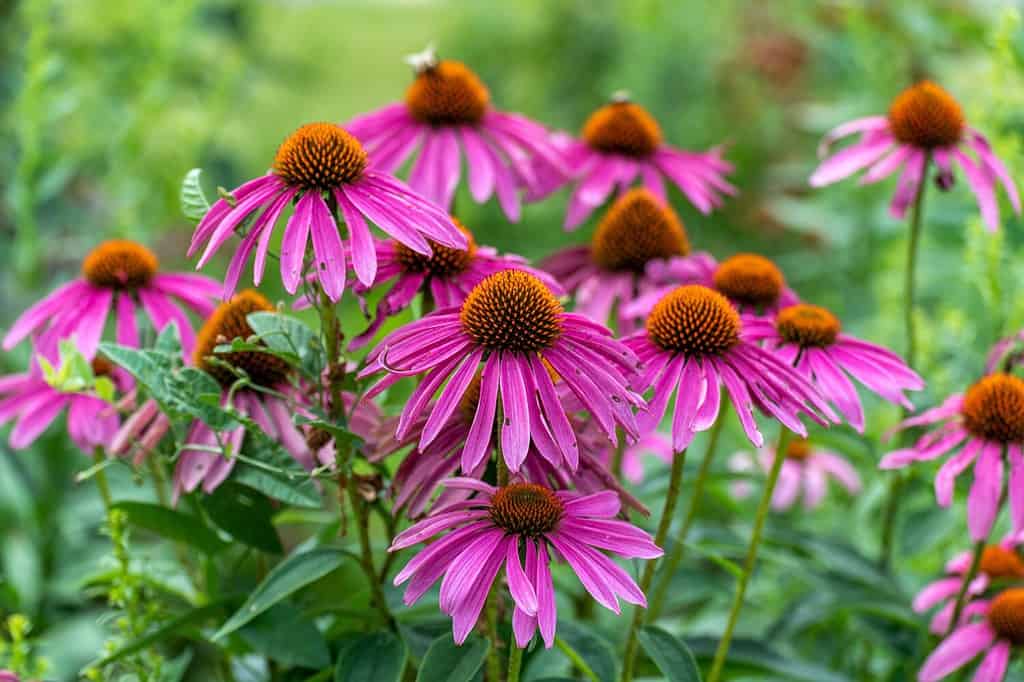
It takes a few years after planting for purple coneflower to bloom.
©Barbara Smits/Shutterstock.com
Coneflowers, also known as echinacea, are a lovely sight to behold growing wild and in gardens all across North America. These bright blossoms are a favorite of butterflies, bees, and songbirds and thrive in zones 3 – 9. Members of the daisy family, echinacea get their name from the Greek word for hedgehog, echinos, because of the spiky center which attracts pollinators. These purple beauties bloom in mid-summer until the first frost of fall. Leave the seed heads after blooming is done to attract a variety of songbirds! Plant coneflowers in full sun and in well-draining soil.
Garden Phlox
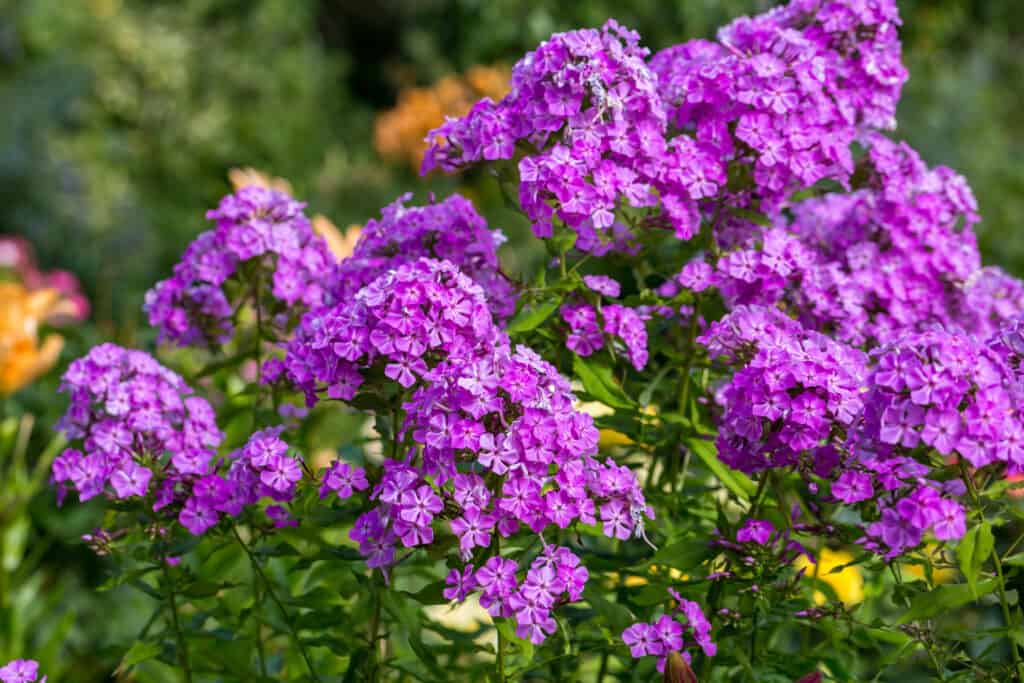
Garden phlox is native to parts of the eastern and central United States.
©S. O. E./Shutterstock.com
Garden phlox is a tall variety that graces many flower gardens with clusters of colorful, dependable blooms. Pollinators love garden phlox but deer find its smell unpleasant so there’s no danger of them trampling your phlox patch. It grows in clumps that reach heights of between 3 – 5 feet in height and flowers from mid-to-late summer. While somewhat tolerant of a little shade – it does best in full sun in zones 2 – 9. Phlox doesn’t like to sit in wet soil – so don’t overwater.
Astilbe

Astilbes are a favorite of pollinators and are deer-resistant.
©Tanya_Terekhina/Shutterstock.com
Unlike the other flowers in our bonus list, astilbes can thrive in moist semi-shade. These delicate, feathery flowers top fern-like leaves that look at home in a tree-shaded garden. With proper watering, these clump-forming perennials will provide blooms throughout the summer. Deer and rabbits dislike astilbes’ scent – but butterflies are very attracted to this versatile plant. Hardiest to zone 4 and hardy under the right conditions to zone 9 – astilbes are a lovely addition to a cutting garden and dry beautifully for dried arrangements. Full sun will burn these fragile flowers and deep shade will produce few blossoms. Light to moderate shade is just right and will provide the astilbe optimum conditions for a summer full of beauty.
The photo featured at the top of this post is © Peeraphat/Shutterstock.com
Sources
- Site Editor, Available here: https://www.rhs.org.uk/plants/articles/graham-rice/perennials-and-bulbs/10-award-winning-summer-perennials
- Nikki Tilley Author of The Bulb-olicious Garden, Available here: https://www.gardeningknowhow.com/ornamental/flowers/spiderwort/growing-spiderworts.htm#:~:text=Spiderwort%20plants%20do%20best%20in,(20.5%2D30.5%20cm.)
- DAvid Beaulieu, Available here: https://www.thespruce.com/taxonomy-of-stella-de-oro-daylily-2132564
Thank you for reading! Have some feedback for us? Contact the AZ Animals editorial team.






